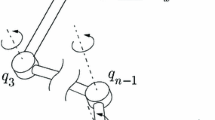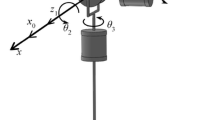Abstract
It is an urgent problem for robots to operate complex tasks with some unknown motion mechanisms caused by the strong coupling of force and motion. However, humans can perform complex tasks well due to their natural evolution and postnatal training. A novel biomimetic control method based on a human motion mechanism with high movement adaptability is proposed in this paper. The core is to present a novel variable-parameter compliance controller based on human operation mechanisms with an action-planning method derived from optimization by human motion, and the main contribution is to change the parameters of compliance controller according to human operating intention synchronized with humanoid motion; this change could establish a humanoid map between the force and motion for a seven degree-of-freedom redundant manipulator to deal with the unknown motion mechanism in complex tasks, so the redundant manipulator can operate complex tasks with high performance. Sufficient experiments were performed, and the results validated the effectiveness of the proposed algorithm.
Similar content being viewed by others
References
Reichhardt T. NASA opens its arms to robot options for saving telescope. Nature, 2004, 429: 4
Kirschner D, Velik R, Yahyanejad S, et al. A collaborative robot for piecing together a tangram puzzle. In: Proceedings of the 2016 Springer International Conference on Interactive Collaborative Robotics. Budapest: Springer, 2016. 243–251
Dietrich A, Wimbock T, Albu-Schaffer A, et al. Reactive whole-body control: dynamic mobile manipulation using a large number of actuated degrees of freedom. IEEE Robotics & Automation Magazine, 2012, 19: 20–33
Diftler M A, Mehling J S, Abdallah M E, et al. Robonaut 2 - The first humanoid robot in space. In: Proceedings of the 2011 IEEE International Conference on Robotics & Automation. Shanghai: IEEE, 2011. 2178–2183
Iagnemma K, Overholt J. Analysis of human-robot interaction at the DARPA robotics challenge trials. J Field Robotics, 2015, 32: 420–444
Dragan A, Srinivasa S. Integrating human observer inferences into robot motion planning. Auton Robot, 2014, 37: 351–368
Hogan N. Impedance control: An approach to manipulation. Asme Trans J Dyn Syst Measurement Control, 1984, 107: 304–313
Wu C H, Hwang K S. Nonlinear neuromuscular control for robot compliance control. In: Proceedings of the 1993 IEEE International Symposium on Intelligent Control. Chicago: IEEE, 1993. 238–243
Al-Jarrah O M, Zheng Y F. Intelligent compliant motion control. IEEE Trans Syst Man Cyber-Part B, 1998, 28: 116–22
Zhang W, Huang Q, Du P, et al. Compliance control of a humanoid arm based on force feedback. In: Proceedings of the 2005 IEEE International Conference on Information Acquisition. Hong Kong: IEEE, 2005. 528–531
Ott C, AlbuSchäffer, Alin, Kugi A, et al. Decoupling based Cartesian impedance control of flexible joint robots. In: Proceedings of the 2003 IEEE International Conference on Robotics & Automation. Taipei: IEEE, 2003. 3101–3107
Ikeura R. Optimal variable impedance control for a robot and its application to lifting an object with a human. In: Proceedings of the 2002 IEEE International Workshop on Robot & Human Interactive Communication. Berlin: IEEE, 2002. 500–505
Tsumugiwa T, Yokogawa R, Hara K. Variable impedance control based on estimation of human arm stiffness for human-robot cooperative calligraphic task. In: Proceedings of the 2017 IEEE International Conference on Robotics & Automation. Washington: IEEE, 2017. 644–650
Newman W S, Dohring M E. Augmented impedance control: An approach to compliant control of kinematically redundant manipulators. In: Proceedings of the 1991 IEEE International Conference on Robotics & Automation. Sacramento: IEEE, 1991. 30–35
Lin Z C, Patel R V, Balafoutis C A. Impact reduction for redundant manipulators using augmented impedance control. J Robotic Syst, 1995, 12: 301–313
Ott C, Dietrich A, Albu-Schäffer A. Prioritized multi-task compliance control of redundant manipulators. Automatica, 2015, 53: 416–423
Malysz P, Sirouspour S. Trilateral teleoperation control of kinematically redundant robotic manipulators. Int J Robot Res, 2011, 30: 1643–1664
Sentis L, Khatib O. Prioritized multi-objective dynamics and control of robots in human environments. In: Proceedings of the 4th IEEE/RAS International Conference on Humanoid Robots. Santa Monica: IEEE, 2004. 764–780
Platt R, Abdallah M, Wampler C. Multiple-priority impedance control. In: Proceedings of the 2011 IEEE International Conference on Robotics & Automation. Shanghai: IEEE, 2011. 6033–6038
Peng Z X, Adachi N. Compliant motion control of kinematically redundant manipulators. IEEE Trans Robot Automat, 1993, 9: 831–836
Ficuciello F, Villani L, Siciliano B. Variable impedance control of redundant manipulators for intuitive human-robot physical interaction. IEEE Trans Robot, 2015, 31: 850–863
Howard M, Braun D J, Vijayakumar S. Transferring human impedance behavior to heterogeneous variable impedance actuators. IEEE Trans Robot, 2013, 29: 847–862
Kulic D, Venture G, Yamane K, et al. Anthropomorphic movement analysis and synthesis: A survey of methods and applications. IEEE Trans Robot, 2016, 32: 776–795
Maciejasz P, Eschweiler J, Gerlach-Hahn K, et al. A survey on robotic devices for upper limb rehabilitation. J NeuroEng Rehabil, 2014, 11: 3
Ott C, Mukherjee R, Nakamura Y. Unified impedance and admittance control. In: Proceedings of the 2010 IEEE International Conference on Robotics and Automation. Anchorage: IEEE, 2010. 554–561
Author information
Authors and Affiliations
Corresponding authors
Additional information
This work was supported by the National Key Research and Development Program of China (Grant No. 2018YFB1305300), the Key Program of the National Natural Science Foundation of China (Grant Nos. 61733001, U1713215), and the National Natural Science Foundation of China (Grant Nos. 61573063, 61873039).
Rights and permissions
About this article
Cite this article
Mo, Y., Jiang, Z., Li, H. et al. A kind of biomimetic control method to anthropomorphize a redundant manipulator for complex tasks. Sci. China Technol. Sci. 63, 14–24 (2020). https://doi.org/10.1007/s11431-019-9542-5
Received:
Accepted:
Published:
Issue Date:
DOI: https://doi.org/10.1007/s11431-019-9542-5




